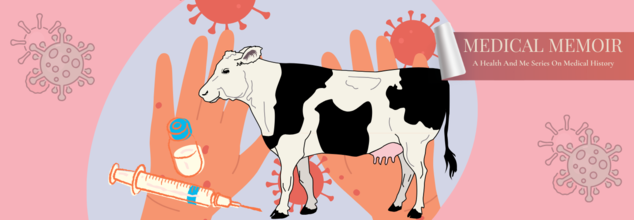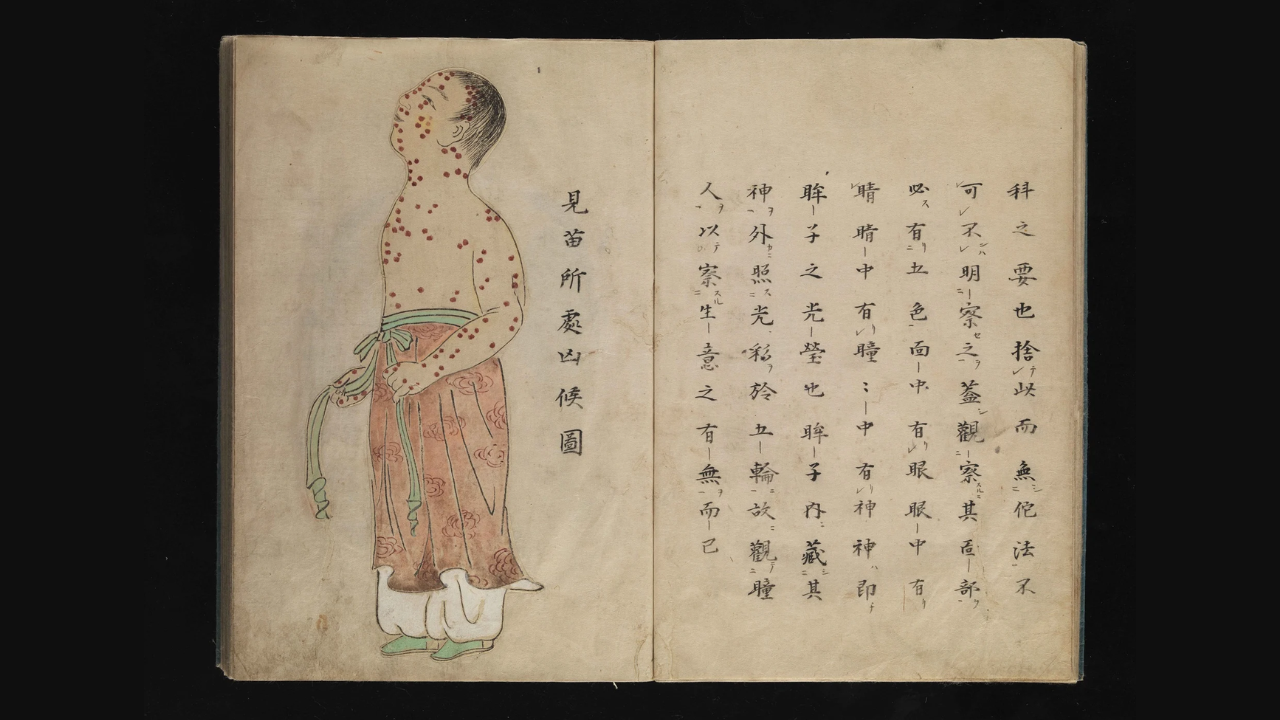- Health Conditions A-Z
- Health & Wellness
- Nutrition
- Fitness
- Health News
- Ayurveda
- Videos
- Medicine A-Z
- Parenting
Medical Memoir: The Accidental Development Of The Small Pox Vaccine

Credits: Canva
'Medical Memoir' is a Health & Me series where we delve into some of the most intriguing medical history and unveil how medical innovations have evolved overtime. Here, we trace the early stages of all things health, whether a vaccine, a treatment, a pill, or a cure.
As per the World Health Organization (WHO), smallpox was officially eradicated in 1980. The last naturally occurring case was diagnosed in Somalia in 1977. In 1980, the WHO declared it to be eradicates, along with the World Health Assembly, marking it as the first human infectious disease to be eradicated worldwide.
So, why are we topic about it today?
Well, for two reasons. What makes it very special is because it was the only human disease to be eradicated so far, mentions WHO. Secondly, the vaccine that worked for its eradication was developed by accident.
A Disease Centuries Old

For centuries, smallpox was humanity’s most merciless enemy — wiping out millions without regard for age, status or geography. It struck kings and commoners alike, killing at least one in every three it infected. In its deadliest form, the toll was even worse.
The disease didn’t just kill — it tortured. Victims first faced high fever, relentless vomiting, and painful mouth sores. Then came the hallmark: fluid-filled blisters that erupted across the body like a cruel constellation. Death often followed within two weeks. And for those who lived, the aftermath could be just as cruel — many were left blind, scarred, or infertile for life.
The disease was indeed deadly, it infected Mozart and also Abraham Lincoln.
The worst part? No cure was known. It began as early as in the 1350 BCE, studied in Egyptian mummies. There were practices too in parts of Africa, called variolation, name for smallpox. We also find written accounts from China from the mid-1500s that also describe forms of variolation used in China, where smallpox scabs were dried, ground and blown into the nostril using a pipe. In India, a similar method known as inoculation involved pricking the skin of healthy children with a lancet or needle dipped in material from smallpox pustules. Historical records from the 18th century indicate that this practice had been in use for centuries.
An Accidental Observation That Saved Lives

It was not until May 1796, when the world's first smallpox vaccine had been demonstrated, using the same principle as variolation, but with a less dangerous viral source, cowpox.
It was an English physician Edward Jenner who noticed that milkmaids who had contracted cowpox appeared to be protected form smallpox. This led him to hypothesize that cowpox could be used to induce immunity against smallpox. In 1796, Jenner inoculated a young boy, James Phipps, and exposed him to smallpox. He did not develop the disease.
This is how Phipps became the first person in history to be vaccinated against smallpox.
While the experiment, absolutely against today's safety standards, proved the principle of vaccination and marked the very beginning of the chapter that ended smallpox.
Delhi Will See Pollution-free Blue Sky In Next 3-4 Years, Says Authority

Credits: iStock
Delhi, on Wednesday morning, woke up to 'very poor' air. The visibility was low and, in fact, the India Meteorological Department (IMD) issued an orange alert for dense fog between 8.30am and 10am. Visibility remained low, and as per the 24-hour average Air Quality Index, Delhi stood at 384, as confirmed by the data from the Central Pollution Control Board (CPCB). In certain areas, including Anand Vihar, AQI remained under 'severe' level, at 452.
This has resulted in cancellation of t least 148 flights and over 150 flights were delayed at the Delhi airport.
However, there may be a silver lining, in an interview with TOI, Tarun Kumar Pithode, who took charge as the new full-time member secretary of the Commission for Air Quality Management (CAQM) said that Delhi can expect "more blue-sky days over next 3-4 years".
How Does The Commission for Air Quality Management Plan To Bring Delhi's Pollution Down?
Delhi’s fight against air pollution is set to intensify over the next few years, with the CAQM outlining a multi-pronged plan aimed at delivering “more blue-sky days” for the capital. Rather than relying on emergency measures alone, the strategy focuses on long-term, structural fixes across transport, industry, energy and regional coordination.
Cutting Emissions at the Source
One of CAQM’s core priorities is reducing pollution from vehicles, which remain a major contributor to Delhi’s poor air quality. The plan pushes for faster adoption of electric vehicles, tighter checks on polluting commercial vehicles, and a stronger public transport network. Scrapping old, high-emission vehicles and discouraging diesel use through stricter enforcement are seen as key steps to curb everyday emissions, not just during winter spikes.
Cleaning Up Industry and Power Generation
Industrial pollution is another major target. CAQM has stressed a shift away from coal and other dirty fuels toward cleaner energy sources. Industries operating in and around Delhi are being pushed to adopt cleaner fuels such as natural gas, along with better emission-control technologies. Power plants in the region are also under scrutiny, with stricter norms to ensure they do not become pollution hotspots during peak winter months.
Tackling Dust and Construction Pollution
Construction dust and road dust significantly worsen Delhi’s air quality, especially during dry months. CAQM’s plan includes stricter enforcement of dust-control norms at construction sites, better mechanised road sweeping, and regular water sprinkling on major roads. Authorities are also being asked to improve urban planning to reduce exposed soil and unpaved areas that contribute to dust pollution.
Managing Seasonal Pollution and Stubble Burning
A major part of Delhi’s pollution problem comes from outside the city, particularly crop residue burning in neighboring states. CAQM has emphasized regional coordination, working with states like Punjab, Haryana and Uttar Pradesh to reduce stubble burning. This includes promoting alternative methods for crop residue management, providing financial incentives, and ensuring accountability when violations occur.
Data-Driven and Year-Round Action
Unlike earlier approaches that focused largely on winter emergencies, CAQM’s plan relies on year-round monitoring and data-driven action. Expanded air-quality monitoring, better forecasting, and early interventions are expected to prevent pollution levels from spiralling out of control. The aim is to move from reactive crisis management to consistent prevention.
A Long Road Ahead
CAQM officials acknowledge that Delhi’s pollution problem will not disappear overnight. However, with coordinated action across sectors and states, they believe the capital can see steady improvement over the next three to four years. The promise of more blue-sky days hinges not just on policy, but on strict enforcement and sustained public cooperation.
The Hidden Health Risk of Flying and the Simple Steps To Prevent It, According To Doctor

Credits: iStock
"There is a big mistake you are making when you fly and no one talks about how to prevent it," writes Dr Rema Malik, a board-certified vascular surgeon, based in Houston, Texas. On her Instagram post she talks about how our body deals with much of a serious challenge once we enter the plane and the cabin doors shut. She points out that while most of us are busy settling into our seats, our veins enter a risky environment that could raise the chance of developing a blood clot. These risks include deep vein thrombosis or DVT. She points out that this risk is not just limited to older adults, but to people with known health issues too.
What Really Happens to Your Body Mid-Flight
Dr. Malik explains that air travel creates what she calls a “three-hit combo” that puts your circulation under stress.
First is prolonged sitting. When you stay seated for hours, your calf muscles, often called your second heart, stop doing their job. These muscles help push blood back up toward the heart. Without movement, blood begins to pool in the legs instead of flowing upward.
Second comes dehydration. Cabin air is extremely dry, far drier than most natural environments. This causes your body to lose moisture faster than you realize. As dehydration sets in, your blood becomes thicker and more sluggish, which makes clot formation easier.
The third factor is cabin pressure. Lower pressure at cruising altitude causes veins to dilate or expand. This stretching weakens the tiny valves inside your veins that normally prevent blood from flowing backward. Gravity then does the rest, encouraging blood to settle in the lower limbs.
This combination is not about discomfort. It is about safety.
Read: Not Boarded Any Flight And Still Monday Feels Like A Jetlag? You Are Not Alone
Why Age Is Not the Only Risk Factor
There is a common belief that blood clots only affect the elderly or people with chronic illnesses. Dr. Malik strongly disagrees. Whether you are 25 or 65, long flights place similar stress on your circulation. Sitting still, dehydration, and pressure changes affect everyone, regardless of how fit or young they feel.
That is why she recommends preparing your body for travel just as seriously as you prepare your suitcase.
Wear the Right Protection Before You Fly
Compression socks are not just for people with medical conditions. Dr. Malik calls them non-negotiable for air travel. A compression level of 15 to 20 mmHg helps mechanically push blood upward, prevents swelling, and supports healthy circulation.
The key is timing. Put them on before you leave home, not after you board the plane, so your veins are supported from the very start.
Hydration Is a Flight Essential
Her rule is simple. Drink eight ounces of water for every hour you are in the air. This helps keep your blood from becoming too thick.
Coffee, alcohol, and wine do not count. In fact, they make dehydration worse. If you are serious about flying safely, water needs to be your main beverage.
Keep Your Calf Muscles Active
Every 30 minutes, Dr. Malik recommends doing 30 ankle pumps. Lift your toes up and down as if you are pressing a gas pedal. This simple movement activates your calf muscles and helps clear stagnant blood from your legs, even if you cannot get up and walk.
As Winter Flu Spreads, Pharmacist Says Be Ready With These 4 Medicines

Credits: Canva
While December arrives with celebrations, food and social gatherings, it is also the time when seasonal illnesses quietly begin to surface. Colds, lingering coughs and flu tend to spread more easily in colder weather, often catching people off guard just as the new year begins. For those hoping to avoid starting January feeling unwell, there are simple steps that can be taken ahead of time.
A pharmacist has urged people to prepare early by stocking up on essential remedies, saying that being organised can help manage symptoms quickly and reduce unnecessary visits to the doctor. According to him, early action makes winter illnesses far easier to handle.
Why Pharmacists Say Preparation Matters Before January
Pharmacists say the key to getting through winter comfortably is preparation before cold and flu season reaches its peak. Keeping a well-stocked medicine cupboard means symptoms can be treated as soon as they appear, without the stress of searching for supplies while already feeling ill.
“Preparation really is half the battle,” said pharmacist Frederick Apenteng from Roseway Labs. “Once you’re unwell, the last thing you want is to be running around looking for paracetamol or trying to buy a thermometer. That’s often when people feel worse than they need to.”
Medicines To Get Ready For Winter Flu
Frederick stresses that starting with the basics is essential. Painkillers such as paracetamol or ibuprofen help manage fever, aches and general discomfort. Throat lozenges or sprays can ease soreness, while keeping two types of cough medicine at home is helpful. One should be an expectorant for chesty coughs, and the other a suppressant for dry, irritating coughs.
The Basics Every Household Should Have
Blocked noses are another common winter complaint, and decongestants can provide quick relief. However, Frederick warns they should not be used for more than five days. For longer-term congestion, saline nasal sprays are a safer option.
Other useful items include rehydration sachets, tissues, hand sanitiser, and honey and lemon for comfort. A digital thermometer allows you to keep track of fever, while vapour rubs or a humidifier can help ease breathing when congestion strikes.
Why Nutrition and Rest Matter for Immunity
Beyond medicines, Frederick highlights the role of nutrition in keeping the immune system strong. “People often feel run down because they’re missing key nutrients,” he explained. “Iron, B vitamins and vitamin C all play important roles in supporting immune defences.”
Eating foods rich in these nutrients, such as leafy greens, citrus fruits and whole grains, can make a noticeable difference. “The biggest immunity boosters are actually sleep, proper nutrition and staying hydrated,” he added.
A Little Planning Now Can Prevent Bigger Problems Later
Preparing in advance can ease both physical discomfort and mental stress. “Having your winter kit ready means you can act quickly at the first sneeze,” Frederick said. “That can stop symptoms from getting worse and helps keep you out of the GP waiting room.”
In short, early rest, basic treatment and preparation can help people move through winter with fewer disruptions.
Be Cautious With Cold and Flu Medicines
While home remedies can be helpful, it is important not to overuse certain products. In some cases, taking too many cold and flu medicines can cause serious problems, including accidental overdose, liver or kidney damage, and rebound congestion.
Always follow dosage instructions carefully and speak to a healthcare professional if you are unsure. Frederick also cautions against prolonged use of nasal decongestant sprays. Using them for more than a few days can trigger a rebound effect, where nasal passages become more blocked than before. This condition is known as rhinitis medicamentosa.
Staying informed, prepared and cautious can make all the difference during the winter months.
© 2024 Bennett, Coleman & Company Limited

